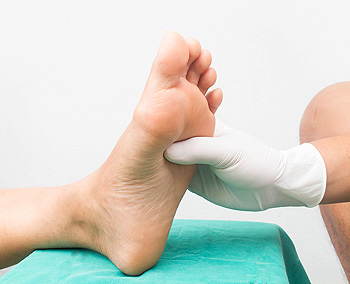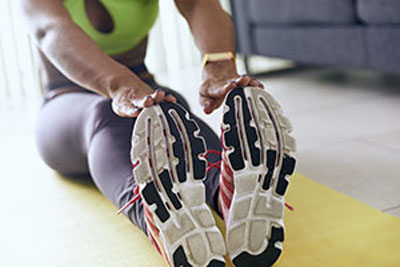Glen Allen Office
(804) 747-3380
 Diabetic neuropathy is a common complication of diabetes that causes nerve damage in the hands and feet. Neuropathy tends to develop slowly, sometimes over several decades, so people with diabetes are urged to closely monitor their foot health. The symptoms of diabetic neuropathy include a “pins and needles” sensation in the feet, sensitivity to touch or a loss of touch, pain, numbness, tingling, burning, difficulties with coordination while walking, and muscle weakness. Diabetic neuropathy can be dangerous and lead to serious complications, as the loss of sensation that it causes in the feet can make foot wounds more likely to form. These wounds tend to heal poorly and may become infected. If you have diabetes, a podiatrist can help you maintain the health of your feet.
Diabetic neuropathy is a common complication of diabetes that causes nerve damage in the hands and feet. Neuropathy tends to develop slowly, sometimes over several decades, so people with diabetes are urged to closely monitor their foot health. The symptoms of diabetic neuropathy include a “pins and needles” sensation in the feet, sensitivity to touch or a loss of touch, pain, numbness, tingling, burning, difficulties with coordination while walking, and muscle weakness. Diabetic neuropathy can be dangerous and lead to serious complications, as the loss of sensation that it causes in the feet can make foot wounds more likely to form. These wounds tend to heal poorly and may become infected. If you have diabetes, a podiatrist can help you maintain the health of your feet.
Neuropathy
Neuropathy can be a potentially serious condition, especially if it is left undiagnosed. If you have any concerns that you may be experiencing nerve loss in your feet, consult with one of our podiatrists from The Podiatry Center. Our doctors will assess your condition and provide you with quality foot and ankle treatment for neuropathy.
What Is Neuropathy?
Neuropathy is a condition that leads to damage to the nerves in the body. Peripheral neuropathy, or neuropathy that affects your peripheral nervous system, usually occurs in the feet. Neuropathy can be triggered by a number of different causes. Such causes include diabetes, infections, cancers, disorders, and toxic substances.
Symptoms of Neuropathy Include:
Those with diabetes are at serious risk due to being unable to feel an ulcer on their feet. Diabetics usually also suffer from poor blood circulation. This can lead to the wound not healing, infections occurring, and the limb may have to be amputated.
Treatment
To treat neuropathy in the foot, podiatrists will first diagnose the cause of the neuropathy. Figuring out the underlying cause of the neuropathy will allow the podiatrist to prescribe the best treatment, whether it be caused by diabetes, toxic substance exposure, infection, etc. If the nerve has not died, then it’s possible that sensation may be able to return to the foot.
Pain medication may be issued for pain. Electrical nerve stimulation can be used to stimulate nerves. If the neuropathy is caused from pressure on the nerves, then surgery may be necessary.
If you have any questions, please feel free to contact one of our offices located in Richmond and Glen Allen, VA . We offer the newest diagnostic and treatment technologies for all your foot care needs.
While there are several different types of flatfoot, all of them involve a loss of the arch—either partial or total. Flexible flatfoot is a common form of this condition where the arch collapses upon standing and returns to normal when there is no weight on the foot. Because having flat feet changes the alignment of the foot (toes point outwardly, the heel points toward the outside of the foot, and the ankle turns in), people with this condition may be more prone to developing bunions and hammertoes. Flexible flatfoot may cause pain in various areas of the foot including the arch, heel, ankle, shin bone, or on the lateral side of the foot. Additionally, there may be some pain in the knee, hip, or lower back, and overall fatigue or aching in the feet or legs. A podiatrist can diagnose flatfoot through an examination and by taking an X-ray. Non-surgical treatment may involve shoe modifications, physical therapy, losing weight, modifying activities, or even wearing ankle or foot orthoses to help support your arches and adjust your gait. For a proper diagnosis and to determine what treatment option is best for you, it is suggested that you visit a podiatrist.
Flatfoot is a condition many people suffer from. If you have flat feet, contact one of our podiatrists from The Podiatry Center. Our doctors will treat your foot and ankle needs.
What Are Flat Feet?
Flatfoot is a condition in which the arch of the foot is depressed and the sole of the foot is almost completely in contact with the ground. About 20-30% of the population generally has flat feet because their arches never formed during growth.
Conditions & Problems:
Having flat feet makes it difficult to run or walk because of the stress placed on the ankles.
Alignment – The general alignment of your legs can be disrupted, because the ankles move inward which can cause major discomfort.
Knees – If you have complications with your knees, flat feet can be a contributor to arthritis in that area.
Symptoms
Treatment
If you are experiencing pain and stress on the foot you may weaken the posterior tibial tendon, which runs around the inside of the ankle.
If you have any questions please feel free to contact one of our offices located in Richmond and Glen Allen, VA . We offer the newest diagnostic and treatment technologies for all your foot and ankle needs.
 Normal sweating is your body’s way of regulating its temperature, and is triggered by a rise in temperature or physical exertion. Hyperhidrosis is characterized by excessive sweating that occurs when none of these factors are present. There are two types of hyperhidrosis: primary—which is the most common and typically appears on specific parts of the body including the feet, and secondary—which can be caused by certain medications, or an underlying medical condition. Excessive dampness of the feet may not only be embarrassing and uncomfortable, but it may even lead to athlete’s foot, odor from bacteria, and a breaking down of the skin. If you find that your feet are continuously wet throughout the day, contact a podiatrist who can examine you to see if hyperhidrosis is present, and use a variety of therapies and medicines to help manage it.
Normal sweating is your body’s way of regulating its temperature, and is triggered by a rise in temperature or physical exertion. Hyperhidrosis is characterized by excessive sweating that occurs when none of these factors are present. There are two types of hyperhidrosis: primary—which is the most common and typically appears on specific parts of the body including the feet, and secondary—which can be caused by certain medications, or an underlying medical condition. Excessive dampness of the feet may not only be embarrassing and uncomfortable, but it may even lead to athlete’s foot, odor from bacteria, and a breaking down of the skin. If you find that your feet are continuously wet throughout the day, contact a podiatrist who can examine you to see if hyperhidrosis is present, and use a variety of therapies and medicines to help manage it.
If you are suffering from hyperhidrosis contact one of our podiatrists of The Podiatry Center. Our doctors can provide the care you need to attend to all of your foot and ankle needs.
Hyperhidrosis of the Feet
Hyperhidrosis is a rare disorder that can cause people to have excessive sweating of their feet. This can usually occur all on its own without rigorous activity involved. People who suffer from hyperhidrosis may also experience sweaty palms.
Although it is said that sweating is a healthy process meant to cool down the body temperature and to maintain a proper internal temperature, hyperhidrosis may prove to be a huge hindrance on a person’s everyday life.
Plantar hyperhidrosis is considered to be the main form of hyperhidrosis. Secondary hyperhidrosis can refer to sweating that occurs in areas other than the feet or hands and armpits. Often this may be a sign of it being related to another medical condition such as menopause, hyperthyroidism and even Parkinson’s disease.
In order to alleviate this condition, it is important to see your doctor so that they may prescribe the necessary medications so that you can begin to live a normal life again. If this is left untreated, it is said that it will persist throughout an individual’s life.
A last resort approach would be surgery, but it is best to speak with your doctor to find out what may be the best treatment for you.
If you have any questions please feel free to contact one of our offices located in Richmond and Glen Allen, VA . We offer the newest diagnostic and treatment technologies for all your foot and ankle needs.
Cracked  heels are a common foot problem that can affect up to one in five adults. While cracked heels aren’t usually a big issue for most, they can lead to discomfort and severe pain. There are a variety of factors that can lead to cracked heels. These include standing for long periods of time, walking barefoot, using harsh soaps, dry skin from the climate, and shoes that don’t support the heels. Medical causes such as a vitamin deficiency, fungal infection, obesity, or pregnancy can also lead to cracked heels. In order to prevent cracked heels, make sure to wear shoes that properly support the heels by avoiding shoes with an open back, tall skinny heel, or shoes that are too tight. Staying hydrated, using a foot cream, avoiding standing in one place for a long period of time, and using custom shoe inserts are all ways to help prevent and treat cracked heels. If you have painful cracked heels, consulting with a podiatrist is suggested for a proper treatment method.
heels are a common foot problem that can affect up to one in five adults. While cracked heels aren’t usually a big issue for most, they can lead to discomfort and severe pain. There are a variety of factors that can lead to cracked heels. These include standing for long periods of time, walking barefoot, using harsh soaps, dry skin from the climate, and shoes that don’t support the heels. Medical causes such as a vitamin deficiency, fungal infection, obesity, or pregnancy can also lead to cracked heels. In order to prevent cracked heels, make sure to wear shoes that properly support the heels by avoiding shoes with an open back, tall skinny heel, or shoes that are too tight. Staying hydrated, using a foot cream, avoiding standing in one place for a long period of time, and using custom shoe inserts are all ways to help prevent and treat cracked heels. If you have painful cracked heels, consulting with a podiatrist is suggested for a proper treatment method.
If the skin on your feet starts to crack, you may want to see a podiatrist to find treatment. If you have any concerns, contact one of our podiatrists from The Podiatry Center. Our doctors can provide the care you need to keep you pain-free and on your feet.
Cracked Heels
It is important to moisturize your cracked heels in order to prevent pain, bleeding, and infection. The reason cracked heels form is because the skin on the foot is too dry to support the immense pressure placed on them. When the foot expands, the dry skin on the foot begins to split.
Ways to Help Heal Them
Ways to Prevent Cracked Heels
If you are unsure how to proceed in treating cracked heels, seek guidance from a podiatrist. Your doctor will help you with any questions or information you may need.
If you have any questions, please feel free to contact one of our offices located in Richmond and Glen Allen, VA . We offer the newest diagnostic and treatment technologies for all your foot care needs.